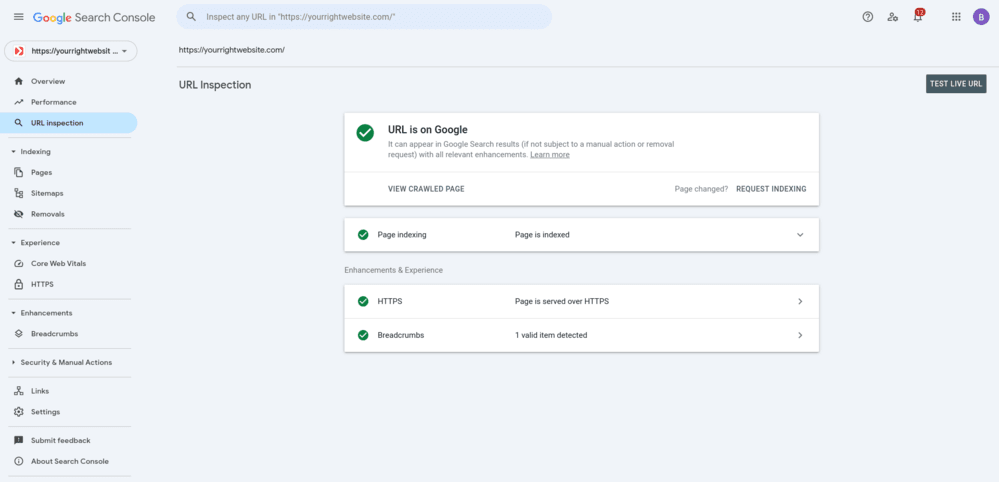So you’ve just launched your new website and you might be wondering what comes next. When will you start getting visitors to your site? When will you rank at the top of Google? This article will go over what to expect as the owner of a brand new website and what to do to ensure that your new website succeeds.
Imagine this: You’ve just launched a beautiful new website for your small business and you’re waiting to start getting some visitors to your site. You watch the analytics and … nothing. No hits, no clicks, no visitors? What’s going wrong? You have the website, why isn’t it getting visitors?
Unfortunately getting website visitors is a bit more complicated than just putting your site out into the either. The launch of your website isn’t the end, it’s the beginning of a process that may take a while, a process that you’ll need to follow in order to grow your website from a nothing into a something. Just like you can’t just put a plant in a pot and leave it and expect it to grow, you can’t just put a website out into the big, big internet and expect traffic. You have to water it.
Getting your new website found by Google
In the movie Field of Dreams, they build a baseball field in the middle of nowhere and say “If you build it they will come”. However, on the internet nothing could be further from this. If you have a website in isolation, no one will even know it exists, let alone visit it.

The way the internet works is that websites link to each other. A website can only be found by Google if there’s another website that links to it. When one website links to another this is called a backlink and backlinks make up a huge part of the internet.
But your website is brand new and you don’t have any backlinks. So, what do you do? Luckily there is another option, a way to tell Google and other search engines about your new website. That option is the Google Search Console, and it’s how you can submit a brand new website to Google.
If you’re a client of Your Right Website, we’ll submit your site to Google for you when we launch your custom website, but if you’re launching a website yourself you’ll also have to submit it to Google yourself. To get started, you’ll need to verify that you own your website, either by adding a DNS entry for Google or adding a special file or meta tag to your website’s code so Google knows you are the owner of the site and that Google has your permission to make changes to the site in their index at the behest of the site’s rightful owner.

Once in the Google Search Console, paste your site’s URL in the box at the top and click the Request Indexing button to have Google crawl your website. It might take about 24 hours, but eventually if you come back to this screen you should see a green checkmark indicating that your site is in Google’s index.
Note that just because your site is in Google’s index, that doesn’t mean that it will be high in Google’s index. Once Google indicates that your site is in their index, there’s a very, very good chance that you won’t be able to see your site appear in the top results even if you type the exact name of your website.
To verify that your site is in Google’s index, you can do a search by URL, such as:
site:yourrightwebsite.com
This tells Google to show all pages for the domain you’ve chosen, in this case yourrightwebsite.com. If you’re only seeing the homepage, you can individually submit additional pages or you can submit your Sitemap to Google using the Sitemaps link on the left hand menu of the Google Search Console.
To submit a Sitemap you’ll need to have a sitemap.xml file (or other XML file that serves as a sitemap) somewhere on your site. If you’re using WordPress, you can use a plugin like The SEO Framework to automatically generate a sitemap.xml file for you. Your sitemap file is usually at yourdomain.com/sitemap.xml, like this:
https://yourrightwebsite.com/sitemap.xml
If you’ve done everything right up until now, your website should be in Google’s index, but you’re not ranking very high yet. Let’s work on getting your website your first bit of traffic and building some backlinks and search authority.
Getting your very first website visitors
Now that your site is live, you want to get your very first website visitors. Your first visitors likely will not come from search engines, instead they’re going to come from your network, including friends, family, existing customers and social media followers.
The first thing you will want to do is add your website to any social media profiles you can, including your Facebook, X (formerly Twitter) and LinkedIn profiles. You want to announce to the world that you have a brand new website and it’s open for business. Make a new post inviting your followers to visit your new website.
If you have a physical store location, be sure to also add your website to your signage and displays. Have a company car or van with your logo and phone number on it? Add your website! Have a business card? Make sure that your website URL is on there.
Your first few visitors will likely trickle in from these initial efforts. If you’re selling online, you might even get a sale or two from these. If you’re using analytics tools like Google Analytics or Matomo you’ll be able to see your first few visitors come in via your dashboard along with where in the world they are located and what type of device they’re using to view your website.
Don’t get too excited just yet though. These first few visitors are not sustainable and you need to start growing your website’s online presence and authority so you can start getting new visitors from search engines like Google. To grow authority you’re going to need two things: content and backlinks.
Building content, the reason people come to your site
Why do people come to your website? It’s not because it looks pretty. It’s because it has something that people find useful. That something is the content. Unfortunately, most content on your website is not strong enough on its own to attract new visitors from Google. For instance, on this website we have a page talking about our custom website design. It’s a perfectly fine page and gets the point across, but there’s nothing to set it apart from the hundreds of thousands of other websites also offering custom web design.
You know what does stand apart? Great written content! In fact, you’re on this site right now not because of my web design services, but because of this very blog post. The number one way to attract new website visitors and build your website’s authority is by blogging.
Every blog article you write is a new piece of content that Google can latch onto to send visitors to your website. Adding new content regularly also shows Google that your website is growing and sends signals to Google that your website is an authority in your space.
But what should you write about? The answer is, anything that’s related to your business. You can write about your process, challenges you face in running your business, why people should choose you over the competition, anything. The more you write the more different keywords and pieces of content Google has to latch onto and start sending traffic to your website.
For instance, on this blog, most of my blog posts don’t get a lot of traffic, but the ones about the Sage theme framework for WordPress get a ton of organic search traffic from Google. The key to making writing work is to notice what works and what gets traffic, then lean into it. When I put out my first article about Sage, I immediately noticed a large uptick in traffic to my site due to that article. So, naturally I wrote some more articles about the Sage framework.
While you can write about anything related to your business, the articles that will do best are articles that will solve a problem your visitors are having. If you can solve their problem, you can get their traffic. Then, once you have their traffic, you can try and convert them to a customer. At the bottom of every article, I always have a prompt asking the user to do something, whether that is to explore my custom web design services, my web developer mentorship services or something else. While the user is happy with your content is a perfect time to try and get them to explore more and convert into a customer.
Blogging is also a great way to start building backlinks, which is the next crucial piece of the SEO puzzle. The more great content you write, the better the chances are that someone links back to to your website.
Backlinks, the signal to Google that your site knows what it’s talking about
You can have the greatest website content in the world, but that will only get you so far. You need backlinks, that is, links from other websites linking back to your site to show Google and other search engines that your website is an authority in your space. Each backlink is like another website is vouching for your site and your content. The more backlinks you get, the more street cred your website has with Google.
However, not all backlinks are built equal. Just like a reference from your cousin Eddie who gets high all the time is unlikely to mean much, a backlink from a shady website likely won’t move the needle with Google. You want to get backlinks from high quality websites that are authorities in their space.
So, how do you get backlinks? We’ll, this is the tricky part. For one thing, you might think you can add backlinks on social media sites like Facebook, Reddit and X. However, these sites know that lots of people will do this so they take precautions to prevent you from sullying their good name with a bad backlink. They do this by making links from their site nofollow, essentially disavowing your links from their site back to yours with Google. You can link to your site from Reddit, but it won’t boost your street cred with Google.
You also don’t want to add a bunch of backlinks from sketchy websites because these won’t move the needle with Google. This is why buying a bunch of backlinks via some ad on Facebook is probably not a good idea. What you really need is other sites in the same niche as you to link to your website. How do you do this? Well, I’ll be honest, it’s hard.
For one, your site has to be worth linking to. The way to make your site worth linking to is by, you guessed it, writing great content. If you write an article people find helpful, funny or controversial people are more likely to link to it. This is great if people can find your content, but what if they can’t?
Well, you can always ask another website for a backlink. If you ask another website nicely for a backlink, they might, just might give you one. The best way to ask is to find a piece of content the other site has written that is relevant to a piece of content you have written and politely ask the site owner to link to your content. Most of the time they’ll say no, but there’s always a chance they’ll say yes. Just be polite and respectful and don’t take a denial personally.

Once you start getting quality backlinks, your site will begin building trust and authority with Google. You can keep an eye on who is linking to your website and how much authority your website has using tools like Ahrefs Backlink Checker. You’ll be able to see who is linking to you, how much authority your website has and how much authority the sites linking to you have. Tools like Semrush can give you an even better idea of where your site stands with backlinks and authority, but expect to pay for anything beyond only a few queries with tools like this.
Growing your website is a process, one that takes time
Even doing everything right, it will take some time for your website to be seen as a trusted authority in your space. The best thing you can do to grow your website is to keep writing great content. Eventually after about six months to a year your site should start building some authority with Google.
Getting your website to rank in Google is a marathon, not a sprint. In addition to writing good content and getting good backlinks, your site will also be affected by how fast it loads and how it ranks on Google’s Core Web Vitals. If you’ve got a slow loading website we would love to help get your site seeing all greens with Google. You might find our blog post on getting all greens on Core Web Vitals helpful. In addition we offer custom website design and development where we build websites optimized for speed and usability.
We also offer our FastTrack web design subscription for only $499 down and $150 a month which contains everything your business needs to establish a professional web presence. Our FastTrack subscription includes everything you need to start ranking with Google, including a website template optimized for speed, lightning fast managed web hosting for WordPress and custom Matomo Analytics.
Get your website up to speed today. Schedule a free consultation to learn more.
